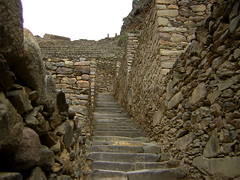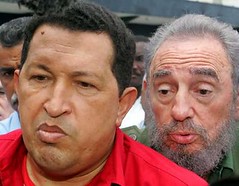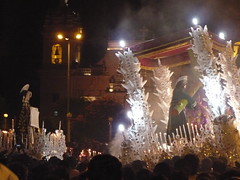I’ve found this really great video of a walk around the ruins of the
Inca citadel of Machu Picchu. Enjoy.
Category: "History"
New Moche tomb discovered
Invoking memories of Walter Alva’s spectacular and world renowned discovery of the Señor de Sipán tomb in 1987, another discovery has been made not far away.
Cruz del Viajero
Placed by Franciscan monks in 1672 in the small town of Magdalena Vieja, now Pueblo Libre, the Traveller’s Cross followed a tradition started by Conquistador Francisco Pizarro, a tradition that required the placement of a cross on the main routes to other parts of the country.
Inti Raymi
The Spanish had yet to arrive in Peru but there was such frantic activity throughout the empire in the week leading up to the 24th of June that it was obvious that something just as big was happening. In fact it happened every year and was very important – but thankfully well-rehearsed Inca rituals meant there was no real cause for alarm.
Qoyllur Rit’i
An event which attracts over 10,000 people each year, mostly local Quechua and Aymara people, Qoyllur Rit’i is a Catholic tradition wholly invented by the indigenous in the 18th Century. This religious experience, rather than being violently imposed on them from Europe, belongs completely to them and is gaining popularity among outsiders.
Peru’s Potatoes
Declared the International Year of the Potato by the United Nations to highlight its importance in reducing world poverty and hunger, particularly in this time of high food prices but static potato prices, this gift to the world from Peru is now a staple food for billions of people.
The Chaski
Chaskis (Chasquis) were the famous Inca messengers, highly athletic runners who were capable of running great distances along the Inca’s extensive network of roads called the Qhapaq Ñam – the royal roads.
Peru’s Firefighters
With a reckless disregard for their own well-being and a commendable regard for the well-being of others, Peru’s firefighters are nothing short of heroes. And it’s not just their physical health they put at risk, it’s their financial health too – Peru’s bomberos are all unpaid volunteers.
Quinoa – The Mother Grain
Quinoa, the grain of the Incas, has been cultivated in the Andean highlands of South America for over 7000 years, yet it is a relative newcomer on the international market. Pronounced “keen-wa”, quinoa comes from the Quechua language spoken by many indigenous people in South America.
It was one of the most sacred foods of the ancient Incas, a plant so nourishing, delicious and vital, they called it chesiya mama; the ‘mother grain’.
Llamas, Alpacas, Vicuñas and Guanacos
Living on the altiplano – the Andean plateau – are the South American camelids. Llamas and Alpacas found themselves domesticated by humans and have lived this way for as much as 6000 years. Guanacos and Vicuñas on the other hand still exist in the wild and are heavily protected by law. They are all somehow able to thrive on the tough vegetation and harsh extremes in temperatures that we find at these altitudes.
Puente Bolognesi
Arequipa’s “Old Bridge” began life on the 11th of June in 1577, but it took until 1608 to be completed at a cost of 150,000 silver pesos. The city was in need of a way across the river Chili from the city’s center, and Spanish architect Juan de Aldaná oversaw the project during all this time.
The White City of Arequipa
As the Inca Mayta Capac passed with his soldiers through the valley in which modern Arequipa sits, some asked to stay behind. “Ari quepay”, he said. Yes, stay.
The Spanish, when they arrived in these lands, often pronounced local words badly and named their new city the Villa Hermosa de la Asunción del Valle de Arequipa. Only Arequipa stuck.





![Barbara ends up doing the Whipping Dance [Featured]](http://farm2.static.flickr.com/1306/1337818770_17d1f42c05_m.jpg)




